
Solutions
- Content Archiving - Email, File and SharePoint Archiving Solution
- Fax Server Solution
- Exchange Solution - Migration, Upgrade and Recovery
- Network and Vulnerability Management
- Web & Mail Security
- Backup & Disaster Recovery Solution
- SAN Storage Virtualization / Replication/Disaster Recovery
- Managed Services
- Application Delivery Solution
- SharePoint Value Added Solution
- Application Systems
Backup & Disaster Recovery Solution
Replay for Windows Servers | Replay for Exchange | Replay for SQL | Reply for Hyper-V |
Replay for Small Business Server | Replay for Desktops | Replay Replication |
Replay for Small Business Server | Replay for Desktops | Replay Replication |
Exchange 2010 Support in Replay 4.4
Exchange 2010 Support
Replay is an Exchange-aware application that supports the VSS writer for Exchange 2010. For single server implementations, Replay protects the active databases. For DAG implementations, passive mailbox database copies can be protected using Replay reducing the performance impact on active databases.
After performing a restore of a volume containing Exchange 2010 databases in a DAG configuration, you may have to activate a copy of a database ( if the database was previously active on this node) or perform a synchronization ( if the database was a copy).
Using Replay on Exchange Mailbox Role Servers
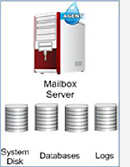 If a server is not a member of a DAG, the active databases are protected. Replay will protect all of the volumes including the system volume, the database volumes and log volumes. Full system recoveries, volume and database recoveries are supported. Mailbox database and volume rollbacks to Exchange 2010 DAG clusters require some manual steps to complete successfully. See the rollback and restore sections below for more details.
If a server is not a member of a DAG, the active databases are protected. Replay will protect all of the volumes including the system volume, the database volumes and log volumes. Full system recoveries, volume and database recoveries are supported. Mailbox database and volume rollbacks to Exchange 2010 DAG clusters require some manual steps to complete successfully. See the rollback and restore sections below for more details.
Using Replay on Database Availability Group Members
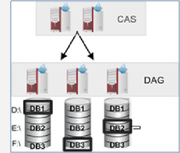 If a server hosting the data being backed up is a member of a database availability group (DAG) and hosts both active and passive database copies, the best practice is to protect the volumes that contain passive copies of the databases. This means that passive copies should be placed on volumes that don’t contain active copies. You need to configure Replay to protect the volumes that contain the passive copies only. In the example below, protect the D volume on DAG member 1, F volume on DAG member 2 and the E volume on DAG member 3. Of course, the system volume should be protected along will all volumes on the CAS servers. Full member node recoveries and passive volumes and database restores are supported.
If a server hosting the data being backed up is a member of a database availability group (DAG) and hosts both active and passive database copies, the best practice is to protect the volumes that contain passive copies of the databases. This means that passive copies should be placed on volumes that don’t contain active copies. You need to configure Replay to protect the volumes that contain the passive copies only. In the example below, protect the D volume on DAG member 1, F volume on DAG member 2 and the E volume on DAG member 3. Of course, the system volume should be protected along will all volumes on the CAS servers. Full member node recoveries and passive volumes and database restores are supported.
Configuring Exchange 2010 Backups
When protecting an Exchange 2010 mailbox server or DAG member server, you should select “Force log truncation prior to checksum check” to enable log truncation on a nightly basis. Truncation occurs after the nightly job is run.
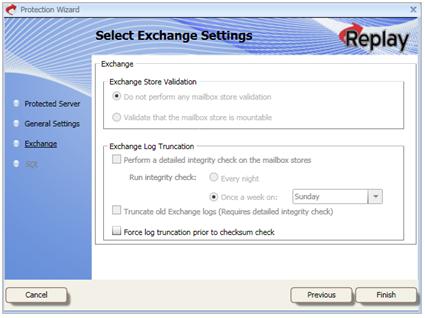
Once the server is protected, the volumes on the Exchange 2010 server are presented.
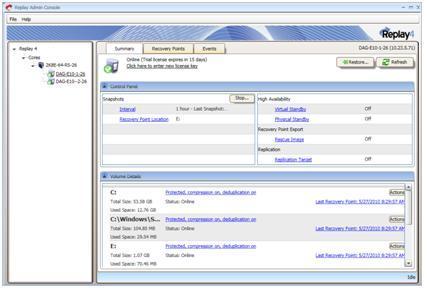
The recovery points are listed as volumes on the Exchange 2010 server.
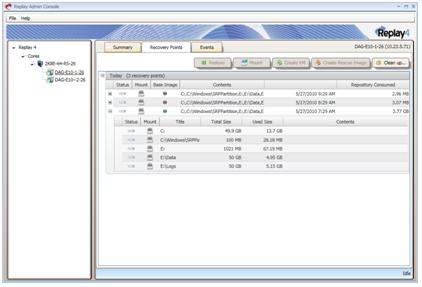
Rolling Back Non-System Volumes
To perform a roll back on a volume containing Exchange 2010 data on a DAG failover cluster node, you must take the following steps:
To perform a restore of an individual mailbox database to an Exchange 2010 DAG failover cluster, the automatic rollback feature in Replay is not available. Instead, the following manual steps must be taken:
For more information about AppAssure,
please contact our Sales Representative at 2556 2162, or email at sales@ppn.com.hk.
Exchange 2010 Support
Replay is an Exchange-aware application that supports the VSS writer for Exchange 2010. For single server implementations, Replay protects the active databases. For DAG implementations, passive mailbox database copies can be protected using Replay reducing the performance impact on active databases.
After performing a restore of a volume containing Exchange 2010 databases in a DAG configuration, you may have to activate a copy of a database ( if the database was previously active on this node) or perform a synchronization ( if the database was a copy).
Using Replay on Exchange Mailbox Role Servers
 If a server is not a member of a DAG, the active databases are protected. Replay will protect all of the volumes including the system volume, the database volumes and log volumes. Full system recoveries, volume and database recoveries are supported. Mailbox database and volume rollbacks to Exchange 2010 DAG clusters require some manual steps to complete successfully. See the rollback and restore sections below for more details.
If a server is not a member of a DAG, the active databases are protected. Replay will protect all of the volumes including the system volume, the database volumes and log volumes. Full system recoveries, volume and database recoveries are supported. Mailbox database and volume rollbacks to Exchange 2010 DAG clusters require some manual steps to complete successfully. See the rollback and restore sections below for more details.Using Replay on Database Availability Group Members
 If a server hosting the data being backed up is a member of a database availability group (DAG) and hosts both active and passive database copies, the best practice is to protect the volumes that contain passive copies of the databases. This means that passive copies should be placed on volumes that don’t contain active copies. You need to configure Replay to protect the volumes that contain the passive copies only. In the example below, protect the D volume on DAG member 1, F volume on DAG member 2 and the E volume on DAG member 3. Of course, the system volume should be protected along will all volumes on the CAS servers. Full member node recoveries and passive volumes and database restores are supported.
If a server hosting the data being backed up is a member of a database availability group (DAG) and hosts both active and passive database copies, the best practice is to protect the volumes that contain passive copies of the databases. This means that passive copies should be placed on volumes that don’t contain active copies. You need to configure Replay to protect the volumes that contain the passive copies only. In the example below, protect the D volume on DAG member 1, F volume on DAG member 2 and the E volume on DAG member 3. Of course, the system volume should be protected along will all volumes on the CAS servers. Full member node recoveries and passive volumes and database restores are supported.Configuring Exchange 2010 Backups
When protecting an Exchange 2010 mailbox server or DAG member server, you should select “Force log truncation prior to checksum check” to enable log truncation on a nightly basis. Truncation occurs after the nightly job is run.

Once the server is protected, the volumes on the Exchange 2010 server are presented.

The recovery points are listed as volumes on the Exchange 2010 server.

Rolling Back Non-System Volumes
To perform a roll back on a volume containing Exchange 2010 data on a DAG failover cluster node, you must take the following steps:
- Ensure that whichever volumes you are rolling back to currently have only active mailbox databases or replicated mailbox database that are in the suspended state.
- Ensure the active mailbox databases corresponding replicated mailbox databases are in the suspended state.
- Roll back the volumes using the Replay Admin Console
- Wait for successful completion of the rollback.
- In EMC mount the restored mailbox database.
- In EMC, on the mailbox database with the Suspended status, perform Update Database Copy operation on the suspended copy. NB: when asked about clearing existing logs or checkpoints always answer yes.
To perform a restore of an individual mailbox database to an Exchange 2010 DAG failover cluster, the automatic rollback feature in Replay is not available. Instead, the following manual steps must be taken:
- Stop all Replay snapshots until resumed
- In the Exchange Management Console (EMC) suspend mailbox database copy for the active mdbs you are about to restore
- In EMC, dismount the active mailbox databases you are about to restore
- In Replay Admin Console, mount as read-only the recovery point that contains the mailbox database you are about to restore
- On the active mailbox databases, move or delete ALL files that comprise the mailbox databases you are restoring from their respective directories
- Copy ALL files that comprise mailbox database that you are restoring from the mounted snapshot to their corresponding directories on the ACTIVE DAG cluster node
- In EMC mount the restored mailbox databases.
- In EMC, on the mailbox databases with the Suspended status, perform Update Database Copy operation on the suspended copy. NB: when asked about clearing existing logs or checkpoints always answer yes.
For more information about AppAssure,
please contact our Sales Representative at 2556 2162, or email at sales@ppn.com.hk.
Copyright © 2021 Pacific Professional Network. All rights reserved.
